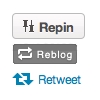Internet users are sending a message most media companies aren’t ready to hear: They want to share, reuse and remix your content.
To leaders of news organizations and other media, this probably means one thing: copyright violation. But with a new style of publishing, they could turn it into an opportunity.
-

- The most popular social networks thrive by letting users repost other people’s content. What if news publishers did the same?
The world’s 1.2 billion Internet users spend one in every five minutes on a social network, the fastest-growing of which are those designed for copying and curating.
Felix Salmon reports that the surging Tumblr microblogging network has nine people curating (by “reblogging” others’ posts) for every one person creating original posts. Then there’s the explosive growth of Pinterest (visits up 55 percent in one month), a social network exclusively for curating images and ideas from around the Web.
And of course tweets are retweeted and Facebook posts reshared. All these networks thrive on the portable, sharable nature of content.
Now contrast that with media companies, which still operate in a Web 1.0 content economy. They host a piece of content exclusively on one website, and the only permissible way to view it is on that page (with its accompanying ads).
This old model of the centralized, copyrighted website is the opposite of the free-sharing, remixing culture that the Internet is embracing through Tumblr and Pinterest.
That’s a disruptive problem for media companies, as Salmon writes: “The old models still work. But the new, more distributed models are I think much more powerful.” He goes on:
The social, digital world is…where the content creators with the broadest reach will be the ones who care the least about protecting their copyrights.
I suspect that we’re only in the very early days of seeing how this is going to disrupt just about every media organization built on the idea of hosting a website and selling ads, including highly socially-attuned ones like the Huffington Post. HuffPo is built on the idea that when stories are shared on Twitter or Facebook, that will drive traffic back to huffingtonpost.com, where it can then monetize that traffic by selling it to advertisers. But in [the] future, the most viral stories are going to have a life of their own, being shared across many different platforms and being read by people who will never visit the original site on which they were published.
So what does the online news publisher of the future do to take advantage of this hypersharing culture? Free the story from the site.
The “story” (whether text, photos or video) still lives on the publisher’s own website, but others are allowed or even encouraged to repost it elsewhere in an approved, mutually beneficial format.
Taking a page (view) from YouTube
If this sounds far-fetched, it shouldn’t. This is exactly the model that helps video sites such as YouTube and Hulu reach millions of people. They go with the Web’s natural currents of sharing. Users get to embed the videos they love wherever they want. YouTube and Hulu still get to show their logos, ads and links to related videos.
But what about the bread-and-butter of online news, the text-based article? Technologically, that’s trickier. But some pieces of the puzzle already are out there.
Storify articles are created on Storify.com, but with a single line of JavaScript can be embedded on any other site. A news organization could use similar technology so that others could embed its full articles, including links and ads.
APIs, like those from The New York Times and the Guardian, enable Web developers to automatically access their content and data to use in their own apps and websites.
The Associated Press’ NewsRight program sells licenses to aggregators that want to reuse stories from the AP or participating newspapers.
What has to be solved first
News organizations in particular still have some problems to solve if they are to move to this distributed-content model:
- How to maintain audience relationships. Publishers create additional value by building communities and audience relationships around their website content. If content scatters far and wide, publishers also need ways of building relationships with that new audience.
- Monitor usage and abuse. If publishers allow people to repost or embed their content under certain conditions, they’ll need to be able to monitor compliance with those conditions and revoke those who abuse the privilege.
The power of the distributed-content model to reach the largest online audience is clear. The only question is which publishers will develop the technology and the business model to take advantage of it.








Comments